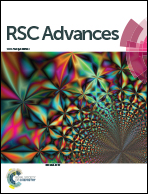Highly efficient performance of activated carbon impregnated with Ag, ZnO and Ag/ZnO nanoparticles as antimicrobial materials†
Abstract
A simple and efficient route for the synthesis of Ag, ZnO and Ag/ZnO nanostructures impregnated on highly porous activated carbon (AC) was developed. The antibacterial activities of AC, Ag–AC, ZnO–AC and Ag/ZnO–AC nanohybrids were evaluated against Gram negative and Gram positive bacteria by the disc diffusion method. Among the four nanostructures, we found that Ag/ZnO–AC exhibited the highest zone of inhibition, killing kinetics and post agent effect compared to the other nanohybrid materials. The minimum inhibitory concentration (MIC) and minimum bactericidal concentration (MBC) of the Ag/ZnO–AC nanohybrid against standard reference cultures were found to be 0.20 mg ml−1 with E. coli and 0.30 mg ml−1 with S. aureus while MBC was found to be 0.35 mg ml−1 with E. coli and 0.6 mg ml−1 with S. aureus. The killing kinetics (3 log10 decrease in 5 h) and post agent effect (2.45 h) were conducted only with E. coli. The Ag/ZnO–AC nanohybrid material showed the highest antimicrobial activity on selected microorganisms and the order of antibacterial activity was AC < ZnO–AC < Ag–AC < Ag/ZnO–AC.


 Please wait while we load your content...
Please wait while we load your content...